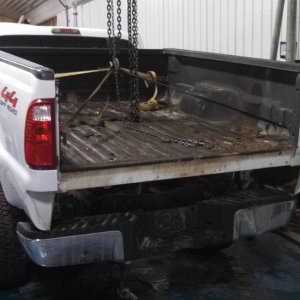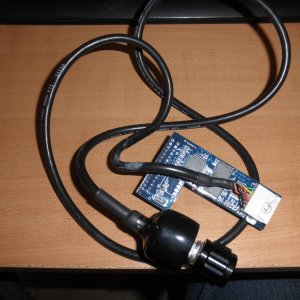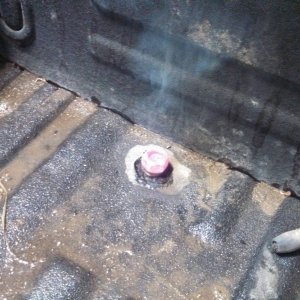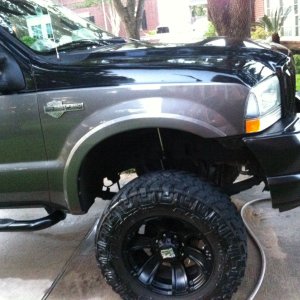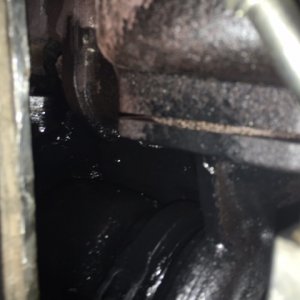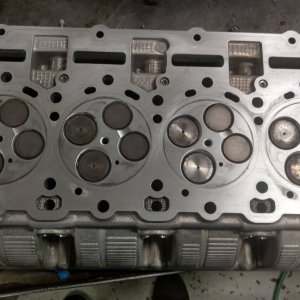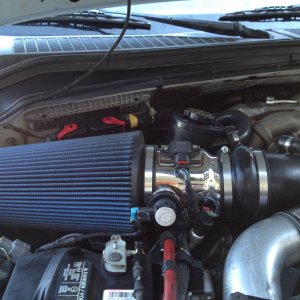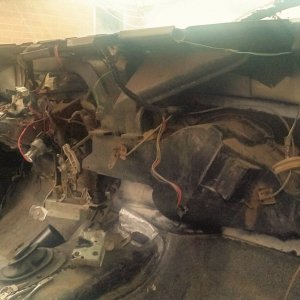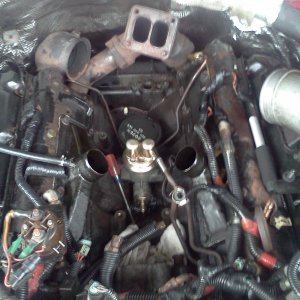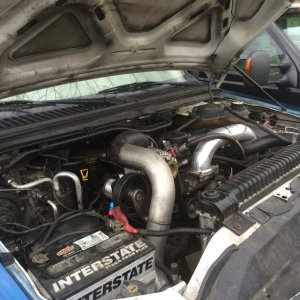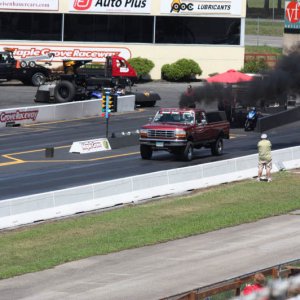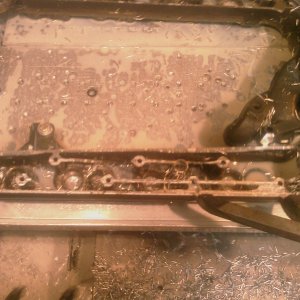Strictly Diesel
Active member
I have been getting a bunch more comments and questions from customers about our 6.0L fuel system kits, particularly our use of banjo bolts in our design. I also keep seeing people make a point of "deleting the banjo bolts", particularly competitors that seem to think this is a big selling point. There seems to be a bad stigma around using banjo bolts in 6.0L fuel systems, I'm not sure I understand why everyone thinks this is some kind of significant advantage...
The fuel rail ports at the front of the cylinder heads are 12mm. Your average 12mm fitting (90° or straight) has a bore of about .240-.260" (yup, about 1/4"). The minor OUTSIDE diameter of the 12mm threaded portion where the o-ring sits is about .380". Obviously you can't get a 3/8" (.375") hole through the middle of a fitting with that small of an outside diameter...hence the 1/4" bore.
Driven Diesel banjo bolts, which are custom designed and made by us, have (3) side holes that EACH have a diameter of about 70% of the main fitting bore...and a center bore larger than most other 12mm fittings. The banjo fitting on the end of our CNC produced tubes is larger and has more internal volume than the stock banjo fittings as well. We DO NOT reuse or modify stock tubes or banjo fittings, our tubing and banjos are larger than stock and totally custom.
So, in both cases (banjo or 90° fitting) you are asking the fuel to make a 90° turn into a bore that is in the neighborhood of 1/4"...from a supply that is larger than 1/4" (generally 3/8" hose). Either way you go, the bore through the 12mm portion of the fitting will be your main restriction, which is not changeable unless you remove the heads, bore the threads out and retap to accept a larger fitting.
To further make my point, here are some calculated comparisons. The calculator I used was pretty basic. These numbers are NOT accurate flow for diesel fuel in our applications, they are based on water and a fixed pressure I couldn't adjust. They are for COMPARISON PURPOSES ONLY and do not reflect the actual flow rate of diesel fuel in your truck at 60psi, etc! No flow corrections made for the 90° turn since both fittings in question are causing the fuel to do this:
Flow of .375" bore: 21gph (average #6 hose ID)
Flow of .250" bore: 9gph (small ID for average 12mm fitting)
Flow of .260" bore: 10gph (large ID for average 12mm fitting)
Ignore the actual flow numbers and look at the differences...the ID of a 12mm fitting will flow just LESS THAN 50% of what the 3/8" hose feeding it will flow. So even if you put a straight fitting in the end of the fuel rail and run straight 3/8" hose to it, flow WILL be significantly reduced when it reaches the smaller bore of the 12mm fitting.
For reference, the 3 side holes in my banjo fitting will flow in the neighborhood of 4.8gph EACH! That's a combined flow rate of more than 14gph (45-50% more than the average 12mm fitting) when taken on their own. The center bore of my banjo fitting will flow about 12gph (20-30% more than most average 12mm fittings). Obviously the banjo fitting has the same limitations as any other 12mm fitting, the smallest point will determine the flow. In this case, it is NOT the side ports of the banjo fitting though, it's the center bore of the 12mm portion.
So...tell me again how using a banjo bolt with side holes that will outflow the ID of the 12mm portion of the fitting is such a problem...
As for why we designed our system using the banjo bolts and CNC bent tubing instead of just a 90° fitting and hose...VEHICLE COVERAGE and CLEAN INSTALLATION. When we were first building our prototype 6.0L kit, we tried the 90° fitting and hose route, but that would have eliminated every "dual alternator" truck since the bracketry for the second alternator would have hit the fitting. It also left the hoses just kind "hanging out" up front and just didn't look good. When we located the high flow banjo fitting and built some protptypes, we found that we were able to still use the cast in tube guides in the heads and the tubes fit tighter to the heads and looked more "factory". The banjo style tubes also fit a bunch better in the rear around the exhaust up-pipes. The high flow banjo setup gives our customers the best of both worlds, significantly increased flow over stock and OEM quality fit.
Hopefully this answers some questions.
The fuel rail ports at the front of the cylinder heads are 12mm. Your average 12mm fitting (90° or straight) has a bore of about .240-.260" (yup, about 1/4"). The minor OUTSIDE diameter of the 12mm threaded portion where the o-ring sits is about .380". Obviously you can't get a 3/8" (.375") hole through the middle of a fitting with that small of an outside diameter...hence the 1/4" bore.
Driven Diesel banjo bolts, which are custom designed and made by us, have (3) side holes that EACH have a diameter of about 70% of the main fitting bore...and a center bore larger than most other 12mm fittings. The banjo fitting on the end of our CNC produced tubes is larger and has more internal volume than the stock banjo fittings as well. We DO NOT reuse or modify stock tubes or banjo fittings, our tubing and banjos are larger than stock and totally custom.
So, in both cases (banjo or 90° fitting) you are asking the fuel to make a 90° turn into a bore that is in the neighborhood of 1/4"...from a supply that is larger than 1/4" (generally 3/8" hose). Either way you go, the bore through the 12mm portion of the fitting will be your main restriction, which is not changeable unless you remove the heads, bore the threads out and retap to accept a larger fitting.
To further make my point, here are some calculated comparisons. The calculator I used was pretty basic. These numbers are NOT accurate flow for diesel fuel in our applications, they are based on water and a fixed pressure I couldn't adjust. They are for COMPARISON PURPOSES ONLY and do not reflect the actual flow rate of diesel fuel in your truck at 60psi, etc! No flow corrections made for the 90° turn since both fittings in question are causing the fuel to do this:
Flow of .375" bore: 21gph (average #6 hose ID)
Flow of .250" bore: 9gph (small ID for average 12mm fitting)
Flow of .260" bore: 10gph (large ID for average 12mm fitting)
Ignore the actual flow numbers and look at the differences...the ID of a 12mm fitting will flow just LESS THAN 50% of what the 3/8" hose feeding it will flow. So even if you put a straight fitting in the end of the fuel rail and run straight 3/8" hose to it, flow WILL be significantly reduced when it reaches the smaller bore of the 12mm fitting.
For reference, the 3 side holes in my banjo fitting will flow in the neighborhood of 4.8gph EACH! That's a combined flow rate of more than 14gph (45-50% more than the average 12mm fitting) when taken on their own. The center bore of my banjo fitting will flow about 12gph (20-30% more than most average 12mm fittings). Obviously the banjo fitting has the same limitations as any other 12mm fitting, the smallest point will determine the flow. In this case, it is NOT the side ports of the banjo fitting though, it's the center bore of the 12mm portion.
So...tell me again how using a banjo bolt with side holes that will outflow the ID of the 12mm portion of the fitting is such a problem...
As for why we designed our system using the banjo bolts and CNC bent tubing instead of just a 90° fitting and hose...VEHICLE COVERAGE and CLEAN INSTALLATION. When we were first building our prototype 6.0L kit, we tried the 90° fitting and hose route, but that would have eliminated every "dual alternator" truck since the bracketry for the second alternator would have hit the fitting. It also left the hoses just kind "hanging out" up front and just didn't look good. When we located the high flow banjo fitting and built some protptypes, we found that we were able to still use the cast in tube guides in the heads and the tubes fit tighter to the heads and looked more "factory". The banjo style tubes also fit a bunch better in the rear around the exhaust up-pipes. The high flow banjo setup gives our customers the best of both worlds, significantly increased flow over stock and OEM quality fit.
Hopefully this answers some questions.

